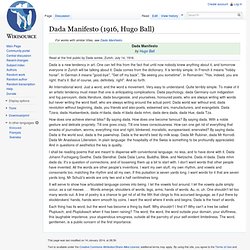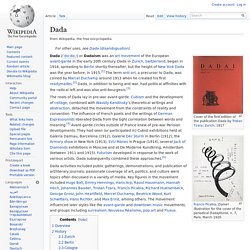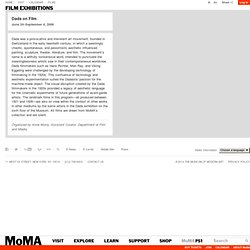

Dada Manifesto (1916, Hugo Ball) Dada is a new tendency in art.

One can tell this from the fact that until now nobody knew anything about it, and tomorrow everyone in Zurich will be talking about it. Dada comes from the dictionary. DADA, the DADA Manifesto, Tristan Tzara. Dada. Dada (/ˈdɑːdɑː/) or Dadaism was an art movement of the European avant-garde in the early 20th century.

Dada in Zurich, Switzerland, began in 1916, spreading to Berlin shortly thereafter, but the height of New York Dada was the year before, in 1915.[1] The term anti-art, a precursor to Dada, was coined by Marcel Duchamp around 1913 when he created his first readymades.[2] Dada, in addition to being anti-war, had political affinities with the radical left and was also anti-bourgeois.[3] Francis Picabia, Dame! Illustration for the cover of the periodical Dadaphone, n. 7, Paris, March 1920 Overview[edit] Dada Films. Surrealism and Dada § Aesthetics and Philosophy of Film.
Dada film. Dada on Film. June 24–September 4, 2006 Dada was a provocative and irreverent art movement, founded in Switzerland in the early twentieth century, in which a seemingly chaotic, spontaneous, and pessimistic aesthetic influenced painting, sculpture, theater, literature, and film.

The movement’s name is a willfully nonsensical word, intended to punctuate the meaninglessness artists saw in their contemporaneous worldview. Dada filmmakers such as Hans Richter, Man Ray, and Viking Eggeling were challenged by the developing technology of filmmaking in the 1920s. This confluence of technology and aesthetic experimentation suited the Dadaists’ passion for the machine-made object.